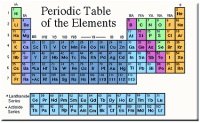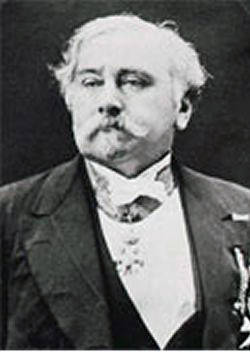What Alexandre Achieved
 All Periodic Tables list the elements in order of a particular property. A property which can be expressed by a number (such as relative atomic mass) is better than a property which cannot (such as color). In 1860 a conference was held in Karlsruhe (Germany) which produced a much more accurate list of atomic weights than previously available. (Not only were some earlier values slightly inaccurate, faulty reasoning had led to some being a half or a third of the correct value). Alexandre Béguyer de Chancourtois was the first person to list the known elements in order of increasing weight of their atoms.
tellurique flat/tube chart
All Periodic Tables list the elements in order of a particular property. A property which can be expressed by a number (such as relative atomic mass) is better than a property which cannot (such as color). In 1860 a conference was held in Karlsruhe (Germany) which produced a much more accurate list of atomic weights than previously available. (Not only were some earlier values slightly inaccurate, faulty reasoning had led to some being a half or a third of the correct value). Alexandre Béguyer de Chancourtois was the first person to list the known elements in order of increasing weight of their atoms.
tellurique flat/tube chart
In 1862, a year before John Alexander Reina Newlands published his classification of the elements, the Law of Octaves, and about 7 years prior to Mendeleev’s Periodic System development, de Chancourtois created a fully-functioning and unique system of organizing the chemical elements. He devised a spiral graph that was arranged on a cylinder which he called Vis Tellurique, or telluric helix because tellurium was the element in the middle of the graph. de Chancourtois ordered the elements by increasing atomic weight and with similar elements lined up vertically, and with all the elements in an unbroken order. He plotted the equivalent weights on the surface of a cylinder with a circumference of 16 units, the approximate atomic weight of oxygen.
The resulting spiral chart - in three dimensions - permitted similar elements to occur at corresponding points above or below one another on the cylinder without breaking the number sequence. Thus, he suggested that "The properties of (The elements) are the properties of numbers", and was the first scientist to recognize that similar elements occurred at regular atomic weight intervals - the basic principle of all succeeding periodic tables.
Using this idea he was able to calculate energies e1, e2, e3, etc., for possible orbits of the electron. He further postulated that emission of light occurred when an electron moved from one orbit to a lower-energy orbit; absorption was accompanied by a change to a higher-energy orbit. In each case the energy difference produced radiation of energy h?, where ? is the frequency.
Despite de Chancourtois' work, his publication attracted little attention from chemists around the world. He presented the paper to the French Academy of Sciences which published it in Comptes Rendus, the academy's journal. de Chancourtois's original diagram was left out of the publication, making the paper hard to comprehend.
tellurique chart
However, the diagram did appear in a less widely-read geological pamphlet. The paper also dealt mainly with geological concepts, and did not suit the interests of many chemistry experts. It was not until 1869 that Dmitri Mendeleev's periodic table attracted attention and gained widespread scientific acceptance.
Check out a timeline of the Telluric Helix or Screw. Who is Mendeleev?


